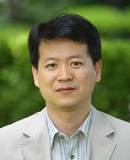
Plenary Lecture
Modeling of Capillary Tubes and Refrigerator in view of Reduced Electric Power Consumption

Professor Ji Hwan Jeong
School of Mechanical Engineering
Pusan National University
Korea
E-mail: jihwan@pusan.ac.kr
Abstract: Residential and commercial buildings are responsible for approximately 40% of energy consumption in developed countries. Approximately 50% of building energy consumption is attributed to air-conditioning and refrigeration. Refrigerators and freezers are usually operates all year round. That is why both government and public are keen to enhance energy efficiency of refrigerators and freezers. In this talk, I will briefly explain energy issues associated with refrigerators and efforts to enhance energy efficiency of them. Refrigerators incorporate heat transfer between the refrigerant in a capillary tube and the refrigerant in a suction line in order to improve energy efficiency and increase cooling capacity. This heat transfer is achieved by a non-adiabatic capillary tube called a capillary tube-suction line heat exchanger (CT-SLHX) and is supposed to improve the performance of the small vapor compression refrigeration cycle by removing some enthalpy of the refrigerant at the evaporator entrance. The thermodynamic properties of the refrigerant in the capillary tube and suction pipe are influenced by associated phenomena. A mechanistic model was developed for the analysis of the adiabatic as well as non-adiabatic capillary tubes. To investigate the effects of this adiabatic and non-adiabatic capillary tubes on the refrigeration cycle, a computer program was developed based on conservation equations of mass, momentum, and energy. The simulation results show that both the location and length of the heat exchange section influence the coefficient of performance (COP) as well as the cooling capacity. It is noteworthy that the influence was not monotonic; that is, optimal design is necessary to obtain best performance of refrigerators.
Brief Biography of the Speaker: Prof. Ji Hwan Jeong graduated from the Seoul National University, Korea in 1988 and received his Ph.D. from the KAIST (Korean Advanced Institute of Science and Technology) in 1995. He did his post-doctoral research in the Technology Centre in Aerodynamics and Heat Transfer at Oxford University. After three years of research experience at KAERI (Korea Atomic Energy Research Institute), he joined the Faculty of the School of Mechanical Engineering at Pusan National University. He is author of about 80 papers published in international journals and invited book chapters. His research interests include multi-phase flow, heat transfer augmentation, heat exchangers, heat pump, and nuclear power plant safety analysis. He has also consulted in the nuclear and air conditioner industries.